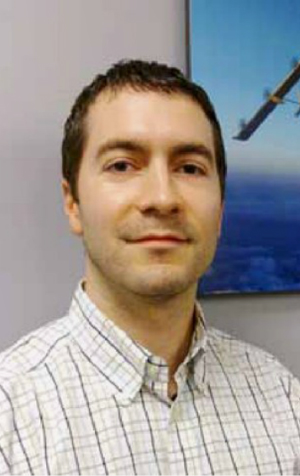Reengineering the Atmosphere
ENG alum studies feasibility of aircraft-driven global cooling

The year is 2059, and global warming is at a fever pitch. Greenland is melting, and climatologists are predicting that New York City will be under water in only five years. Unless, that is, Plan B is put into effect.
Seeing no other option, the UN Security Council gives the go-ahead. The next day, 100 high-performance business jets depart from three designated air bases near the equator. Exploiting strong easterly and westerly winds in the planet’s midsection and emulating the action of a volcano, they disperse sulfuric acid into the stratosphere, where it coalesces into small sulfate particles that reflect sunlight back into space, thereby cooling the planet. The planes fly two or three sorties a day at 65,000 to 80,000 feet, where the sulfate particles have the biggest cooling impact. As they off-load one million metric tons of sulfuric acid each year, the aircraft systematically suspend or even reverse global warming, temporarily holding surface temperatures to precrisis levels while efforts to reduce greenhouse gas emissions catch up.
If such a mission ever flies, Justin McClellan (ENG’04), an aerospace engineer at Aurora Flight Sciences (AFS) Research and Development Center in Cambridge, Mass., will have laid the groundwork. In collaboration with University of Calgary climatologist David Keith and former astronaut Jay Apt, a professor at Carnegie Mellon University’s Tepper School of Business, McClellan completed a yearlong study in 2010 that demonstrated the technical and economic feasibility of an aircraft-driven strategy to mitigate global warming and explained how it would work in the National Geographic Channel special Earth Overhaul.
As the project’s program manager and principal investigator, McClellan’s task was to determine whether a man-made system could disperse sufficient sulfuric acid on a global scale to cool the planet efficiently and affordably.
“The questions we had to address were: one, is it feasible? and two, what would it cost?” he says. “The higher the altitude, the more effective the sulfur is, because it doesn’t settle to the ground as quickly. But it costs more to build an aircraft to fly at higher altitudes.”
To tackle the feasibility question, McClellan and colleagues at AFS evaluated the lift capability, altitude ceiling (below 60,000 feet need not apply), and other performance criteria of existing aircraft, from commercial airliners to fighter jets to cargo planes, modified versions of existing aircraft, and entirely new aircraft design concepts. To estimate costs, McClellan built a financial model that took into account aircraft development, manufacture operations, maintenance, and other expenses.
“We coupled financial models with our in-house aircraft optimization software and evaluated over 230,000 airplane designs,” he says. “Those designs meeting our requirements were then ranked on acquisition and yearly operational costs, all to determine the cheapest way to lift one, three, or five million metric tons per year of sulfur to altitudes of 60,000 to 100,000 feet.”
The ideal choice turned out to be an aircraft design similar to a typical business jet. Equipped with powerful engines and a large payload capacity, it would lift one million metric tons to between 65,000 and 80,000 feet for $2 billion a year, assuming a 20-year amortization of development costs. According to McClellan, deploying 100 aircraft to execute the mission would be comparable to the yearly operations of a small regional airline.
Such a mission would, however, be one of last resort. Sending a fleet of sulfuric acid–bearing aircraft on high-altitude sorties for years on end would amount to a form of geoengineering, or deliberate modification of the environment, to mitigate the effects of man-made greenhouse gas emissions after the fact, rather than nipping them in the bud.
“Once you’ve started doing this and the dispersed sulfur begins blocking some sunlight and cooling temperatures, you’re still not eliminating the greenhouse gases that have accumulated in the atmosphere over the years,” McClellan explains. “Our approach is at best a Band-aid to be applied under extreme circumstances while long-term policies are implemented to reduce greenhouse gas emissions.”
Ironically, exhaust from the aircraft dispersing the sulfuric acid would add to those emissions, but the sulfate particles would more than counteract the resulting heat added to the atmosphere. This approach may also raise levels of acid rain, which is harmful to plants, aquatic animals, and infrastructure, but McClellan estimates that concentrations introduced into the atmosphere would be less than what’s found today in polluted cities such as Beijing or Mexico City. Other concerns include accelerated thinning of the ozone layer and shifting of regional climates, reducing rainfall in some regions while increasing it in others.

While acknowledging potential risks, the study focused largely on demonstrating the technical and economic feasibility of aircraft-assisted geoengineering and logistical considerations such as flight operations, air base locations, sulfuric acid, and fuel supply chain management.
Proving that geoengineering can be feasible and affordable—possibly by a single state or a wealthy individual—is critical to getting governments and societies to consider the option, McClellan maintains.
“Justin’s work was a very good example of how a good aerospace firm hires bright, capable people who can pursue something that goes beyond the state of the art,” says collaborator Apt. “He has a good combination of engineering and economic skills that make him a great leader for Aurora Flight Sciences.”
The grandson of an inventor and machinist for the New Haven Railroad and son of a Wall Street analyst, McClellan has sharpened these two core competencies over the course of his three decades.
Growing up in southern Connecticut, he played with Legos, built electric circuits, flew remote-controlled airplanes, and modified his first car, an Acura Integra, into “a bit of a street racer.” His passion for technological innovation impressed College of Arts & Sciences admissions officers, who redirected him to the College of Engineering based on his application essays. He majored in aerospace engineering and dabbled in economics before fusing the two in his aerospace senior design project—a five-person, multidisciplinary effort to design a short takeoff-and-landing military cargo aircraft.
After graduating in 2004, McClellan worked for small spacecraft firm AeroAstro, and when its Boston office closed in 2006, he moved on to AFS. He has since put his engineering, economic analysis, and program management skills to contributing to revolutionary designs, from the Vulture solar-powered aircraft to the proposed fleet of geoengineering aircraft. He’s currently pursuing three projects aimed at placing very small spacecraft in orbit to conduct focused science experiments.
Despite his demanding workload, McClellan is involved each year in ENG’s aerospace senior design project. He reviews students’ final presentations, is a “client” and advisor for several AFS-inspired student projects that he suggests (e.g., design an aircraft to measure changes in the Greenland ice shelf), and is a guest lecturer.
“These efforts go far beyond what any other alumni have contributed to the course,” says Donald Wroblewski, ENG associate dean for educational initiatives and an adjunct research associate professor of mechanical engineering, who runs the program. “Justin brings a real-world perspective as well as an understanding of the aerospace industry. He mentors teams not only on challenges of a technical nature, but also those requiring communication and organizational skills.”
Mark Dwortzan can be reached at dwortzan@bu.edu.
A version of this article was published in the spring 2012 edition of ENGineer.
Comments & Discussion
Boston University moderates comments to facilitate an informed, substantive, civil conversation. Abusive, profane, self-promotional, misleading, incoherent or off-topic comments will be rejected. Moderators are staffed during regular business hours (EST) and can only accept comments written in English. Statistics or facts must include a citation or a link to the citation.